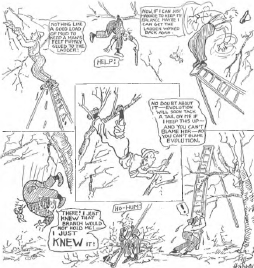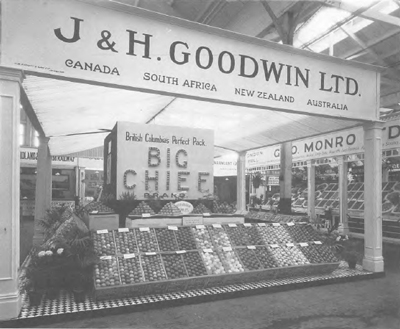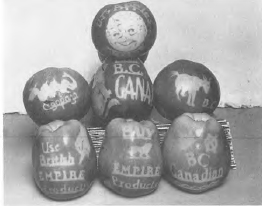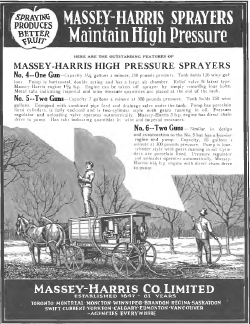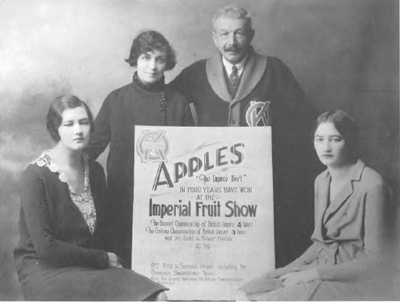News & Events More |
The Produce Marketing Act of 1927By the end of 1926, growers had no confidence that the competitive marketing system would yield an acceptable return for their fruit. The idea of governmental control, as a method of avoiding cut-throat competition and resulting low prices, seemed the only solution to marketing problems. Country Life in British Columbia reported that such legislation had become a common subject of discussion in the Okanagan. That debate was quickened by the resolution of the Board of Directors of Associated Growers on November 2, 1926: that only through compulsory co-operation could satisfactory and equitable distribution of fruit products be effected and that every possible effort should be made towards obtaining the necessary legislation. By January 11, 1927, when the B.C.F.G.A. Annual Convention began, compulsory cooperation was "the chief topic of discussion throughout the fruit growing districts." Most of the resolutions sent in by the various locals were on the marketing question. Under pressure from growers, officials from Associated Growers and the larger independent shippers had met and devised a resolution upon which both sides could agree. After a great deal of discussion, the convention finally passed it in the following form: Whereas, we realize that unless some system of stabilization, which will ensure complete regulation of marketing is adopted for the fruit and vegetable industry of B.C., that many growers will be forced out of the industry. And whereas, we believe that such stabilization, in the interest of all growers, can best be accomplished through a "Committee of Direction" which will regulate the grading, packing, shipping, and marketing of the entire crop, Therefore be it resolved: Further:
The resolution was qualified by twenty-two supplementary proposals detailing the plan. All shippers should be members of a British Columbia Growers' and Shippers' Federation. The Committee of Direction should consist of three members, one to represent the Associated Growers, one for the independent shippers, and the third to be appointed by the government. The Committee should have jurisdiction over distribution of tree fruits and vegetables produced in British Columbia east of the Fraser Valley and also should have powers to regulate f.o.b. prices and the proportions of production which shippers might place on various markets in specific time periods. And finally, the legislation should include stiff penalties for those shippers who infringed the Committee's rulings. Even at the Convention, opposition came from small grower-shippers who had had no part in the formulation of the plan, and from growers who objected strenuously to anything which limited their freedom of action. R.H. McDonald, vice-president of Associated Growers, observed six weeks later: Looking back on what has taken place since the Kelowna convention it would appear that the silence of the opponents at that gathering was a very sinister and a very ominous peace. At the time of the Convention it appeared to some of us that the readiness with which the independents agreed with the main resolution without a dissentient voice, was really more than was to be expected.’ Such misgivings were fully justified. The agreement among the various interest groups- B.C.F.G.A., Associated Growers, independent shippers, and grower-shippers-lasted just long enough to present the Convention resolution to the Agricultural Committee of the British Columbia Legislature on January 24, 1927. But within two days, second thoughts had become evident, and some independents voiced objections to the makeup of the proposed board of control and to the degree of compulsion in the proposed legislation. The issue was clouded by a resolution of the B.C. Dairymen's Association on January 21, calling for control legislation for milk similar to that proposed for fruit/’ E.D. Barrow, the Minister of Agriculture, was a dairy farmer from Chilliwack who strongly supported this latter demand, and he proposed to the Agricultural Committee that the control bill should be expanded to allow the inclusion of all sorts of produce, including dairy products.
This expansion immediately aroused public debate on the marketing bill, and the Vancouver City Council vowed to fight by every means available any control of the milk supply. Mayor L.D. Taylor declared emotionally: I consider it my bounden duty to protest . . . as vigorously as I can, against anything that even suggests the possibility of a combine that will raise the price of dairy products to the detriment of the babies and poor people of the city." One business journal remarked with satisfaction: "It strikes us that the broadening of the scope of the proposed marketing control Bill is all that is necessary to prevent its enactment. E.D. Barrow pushed his measure forward against the rising clamour, and a draft Produce Marketing Act was introduced to the House on February 14, by Dr. H.C. Wrinch, Liberal member for Skeena. Barrow wanted it to be a government measure, but because of Premier John Oliver's opposition, had to accept its presentation as a private member's bill. Oliver attempted to disassociate himself and his government from the bill, which outraged his personal vision of Liberalism. If the Premier had led a strong government, with a powerful majority, he could certainly have imposed his will on those of his cabinet and seated members who championed control. But, instead, he had been, since the last election, in a weak and vulnerable position where the possibility of open dissension or revolt within the cabinet and party had to be avoided at all costs.
The supporters of the Produce Marketing Bill backed down from the controversial milk clause. Milk became a political issue in Vancouver as the City Council and editorial writers pounded away at any monopoly arrangement as a law against motherhood. The Liberal members for the city threatened to vote against the government. The political dangers were not nearly so great in dealing with fruit. Almost two-thirds of the fruit crop was sold on the external market, either in other provinces or other countries, and the British Columbia producers were never in the same position of effective monopoly of the domestic market as the milk producers. Indeed, the competition of Washington apples was one of the chronic complaints of the fruit growers. As for political considerations, most of the fruit districts were, as developments of the McBride era, solidly Conservative anyhow; if the Produce Marketing Act worked well, there might be some improvement for the Liberal cause-and there was nothing to lose.
Control of fruit marketing did not go unopposed. Vociferous opposition was heard in many quarters: from small grower-shippers who had not been consulted, from larger independents who had at first agreed but later had second thoughts, and from growers who were constitutionally opposed to cooperation in any form. Much of the opposition was expressed in incoherent bursts of outrage; one Oyama grower, for example, complained loudly about Bolshevik attacks on British liberties, backed himself up with a quote from Kipling, and ended by calling on "the citizens of Vancouver and Victoria to stand back of the great body of fruit growers and resist this un-British principle that a certain element is trying to introduce in our province." The primary, and the organized, opposition, however, came from independent shippers and grower-shippers, and was voiced on three main grounds: the coercive and compulsory features of the plan, the makeup of the board of control, and the question of whether the board of control or the Shippers' Federation should be supreme in matters of policy. In the argument the shippers insisted that the terms of the bill were radically different from those they had agreed to at the convention in Kelowna. They appealed to anti-orientalism and the fears of bolshevism and Jews, claiming the bill was part of a Jewish plot to control the world's food supply (the very same plot in which Aaron Sapiro had been accused of complicity)! Vignette: Box Labelsby Wayne Wilson (Kelowna Museum)Between 1920 and 1965, packinghouses throughout the province glued brightly coloured and beautifully designed paper labels to each wooden box of apples, pears, cherries, peaches, and plums. With the shift to cardboard boxes in the 1960s, these crate labels were no longer necessary, and since then, the labels have become artifacts dearly sought by antique collectors and museums alike. 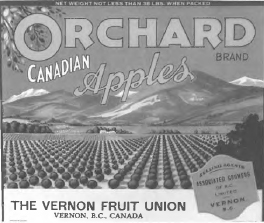 Perhaps one of the most intriguing questions about these labels has to be, “On what basis did the shippers and marketing agents select a label design for printing?" The answer becomes clear by looking at all of the old labels at once. When this is done a pattern emerges. In fact, British Columbia crate labels fall into five distinct categories: Pioneer, Picturesque, Simple Logo, Exotica, and Cultural Connections. Given the purpose of the labels (to catch the consumer's attention), the emergence of each of these categories is much easier to understand. 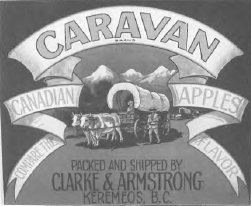 In the first two cases (Pioneer and Picturesque), the fruit industry appears to be echoing the advertising campaign set in place by the Canadian Pacific Railway. To many consumers, especially those in eastern Canada and in Great Britain, the West was the way the CPR portrayed it. It was wild and beautiful all in one. Hence we have Caravan Brand, Black Bear Brand, and Big Chief Brand in the Pioneer category, and Cascade Brand, Orchard Brand, and A-l Brand in the Picturesque. 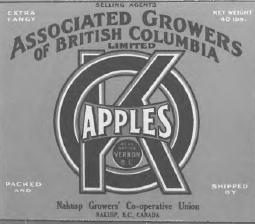 The Simple Logo category is an idea that has been around for hundreds of years and relies on designs that are quickly and easily recognized. It is a marketing strategy used by almost every type of business from automobile manufacturers to television networks. In the fruit industry, Simple Logos include BC Brand, SCE Brand, and, of course, OK Brand. 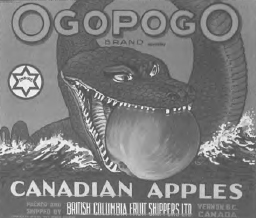 Exotica labels, like Simple Logos, appear to have been designed solely to achieve the highest visual impact-they are bold and brightly coloured. These are whimsical or mystical images including Old Gold Brand, Viking Brand, and our very own Ogopogo Brand. 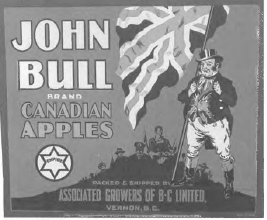 Finally, the Cultural Connections category shows us the power of the link between the Okanagan Valley and its largest foreign market, Great Britain. During the period when crate labels were in use, the valley population was largely British or of British Isles descent. At the same time, the valley's major overseas market was Great Britain and its colonies. As a result, the province's fruit shippers chose images and cultural symbols that spoke of that cultural connection. So it is we have Lion Brand, John Bull Brand, and Castle Brand. With even this brief look, it is clear that crate labels are more than pretty artifacts. They give us clues to the attitudes and the keen perceptions of our pioneer shippers and marketing agents. The Okanagan may have been far removed from its markets, but its use of crate label design was well in step with the best marketing strategies of the time. But this opposition was not sufficient to stop the Produce Marketing Bill, although it, along with the milk clause controversy, served to make the bill "the most contentious piece of legislation considered by the Provincial Legislature in recent years." The general feeling among the members of the legislature appears to have been that the fruit growers had asked for the bill, and should be allowed to see if the experiment would work. Of course, some expressed doubt. Dugald McPherson, Liberal member for Grand Forks- Greenwood, said that, in order "to become effective, the proposed board of control would have to be composed of Mussolini, Jack Dempsey and Aimee Semple McPherson"! The Conservative opposition, encouraged by J.W. Jones, member for South Okanagan, supported the bill; most Conservatives were not enthusiastic about the concept of marketing control, but they were very happy to help the Liberal government tear itself apart.
In the debate on the second reading, February 24 and 25, and on final passage on March 3, 1927, the only votes cast against the bill were by Premier Oliver and seven other members from the government side. They argued vigorously against the measure. Oliver gave a reasoned argument against both its constitutionality and its likely benefits. Captain Ian Mackenzie, Liberal member for Vancouver, whipped up a violent tirade in which he claimed the bill "was purely communistic, and meant that soviets would be set up in the Okanagan and Fraser Valley." But their efforts were fruitless-finally on March 3, "a tired and listless House agreed to the customary resolution to report the bill to the House, prior to ordinary routine of third reading and assent by the Lieutenant-Governor." Contact Us Hours: 9am - 4pm weekdays. t: 250-762-5226 |


